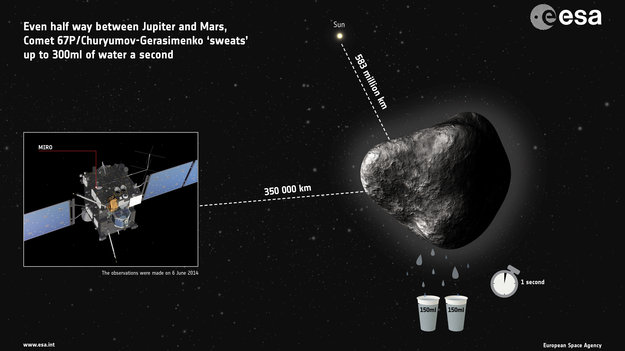Interplanetary station Rosetta: the first data on the study of the comet Churyumov-Gerasimenko

More recently, the interplanetary station Rosetta performed the third key maneuver to slow down, and photographed comet Churyumova Gerasimenko . In addition, part of the scientific tools of the station has entered the operating mode , and the first results of the station’s work are already ready.
The station examined the comet's water emissions (almost every comet emits quite significant amounts of water vapor), and scientists were able to calculate how much water is emitted per second.
It turned out that now the comet throws into outer space about 300 ml of water every second (for clarity, scientists talk about two small plastic cups, of which they usually drink water). Water emission data were obtained by Microwave Instrument for Rosetta Orbiter (MIRO). Scientists are very pleased with the sensitivity of the device, and say they are surprised at how early (a month before approaching the comet) they managed to measure the quantitative loss of water by the comet Churyumov-Gerasimenko.
By the way, the current evaporation rate is quite high - for 100 days of evaporated water with current volumes it will be enough to fill the Olympic pool. The closer this object will be to the Sun, the more active evaporation will take place, so that, most likely, it will be possible to speak not about “cups per second, but about large volumes”.
Water is one of the main components of comets, including compounds such as carbon monoxide (carbon monoxide), methanol and ammonia.
Studying the outflow of water vapor is an important task that allows us to trace the evolution of cometary matter, to study the effect of evaporation on the motion of celestial bodies close to a comet, and also to explain the processes of evolution of the solar system. It is possible that the study of comets will help explain the appearance of water on our planet.
Viaesa
